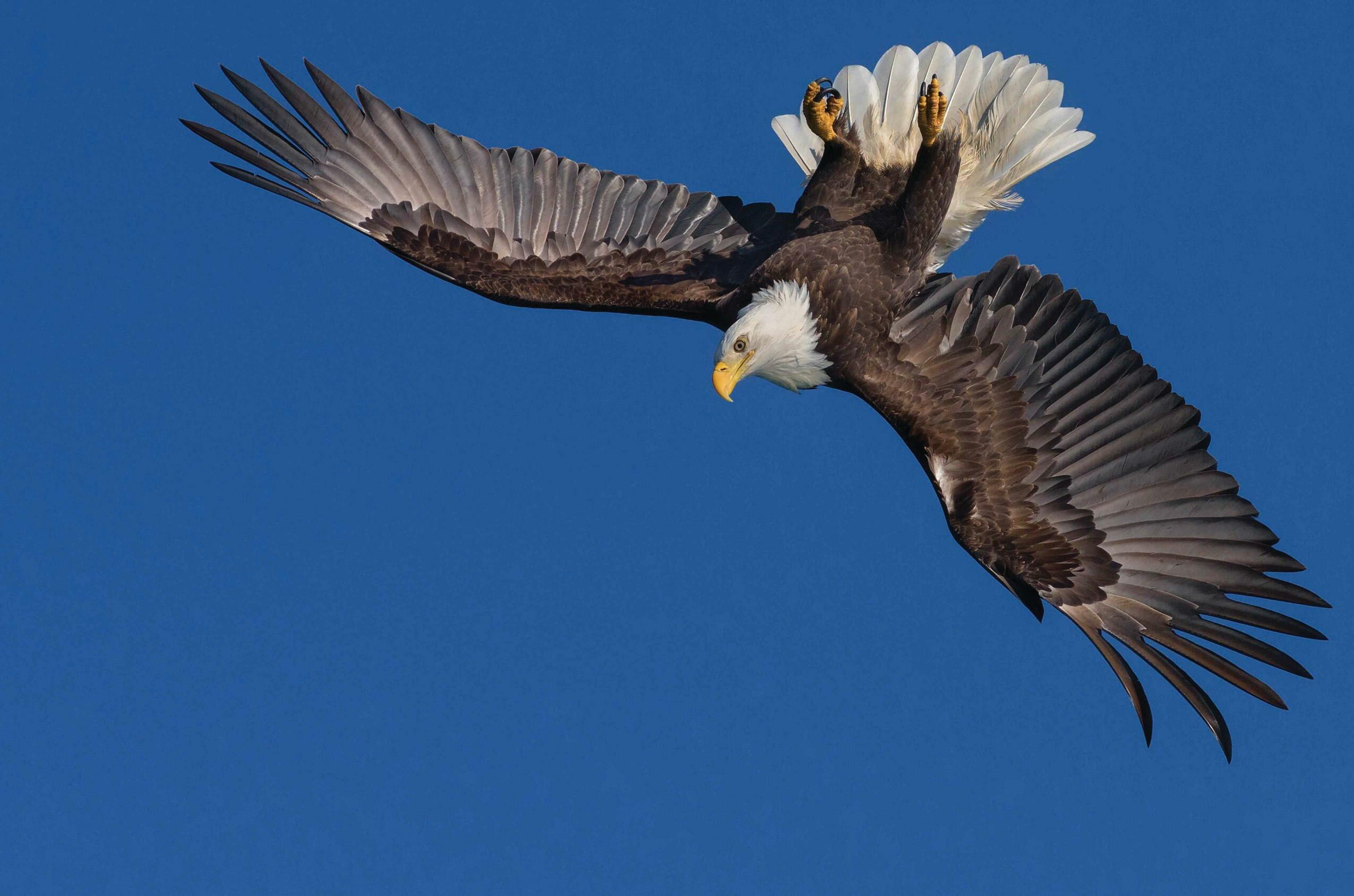Prøve GULL - Gratis
REACH FOR THE SKY
BBC Wildlife
|February 2025
In the 1970s, the bald eagle was on the verge of extinction. Thanks in part to the pioneering work of one young biologist, this magnificent bird has made a spectacular comeback.

SAILING THROUGH THE AIR WITH ITS COLOSSAL, 2m wings outstretched, white head and yellow beak contrasting with its dark body, there’s no mistaking one of North America’s most iconic birds: the bald eagle.
The USA’s national bird has had a rollercoaster ride. Many people are familiar with the species’ astounding recovery following a small start, something but one chapter in this incredible success story usually flies under the radar. A young woman, alone in the woods, hand-feeding a vulnerable pair of eagle chicks.
Before she had embarked on her unusual role as eagle foster-mother, Tina Morris, a graduate from Cornell University, knew little about these birds. “I have to admit,” she recalls, “there were many times when I thought: ‘what on Earth am I doing here? How exactly am I going to manage this?’”
 Her work was a vital intervention. Once abundant across the US, the bald eagle was nearly eradicated by the mid-1900s as a result of hunting, habitat destruction and, most significantly, the pesticide DDT, a cheap and effective chemical that had been widely used in agriculture and as a malaria control since the 1940s.
Her work was a vital intervention. Once abundant across the US, the bald eagle was nearly eradicated by the mid-1900s as a result of hunting, habitat destruction and, most significantly, the pesticide DDT, a cheap and effective chemical that had been widely used in agriculture and as a malaria control since the 1940s.DDT was a disaster for bald eagles. It wasn’t toxic in itself, but the damage had already been done. The chemical lingers in the environment for many years, becoming increasingly concentrated as it travels up the food-chain. It washed into rivers and was absorbed by fish, which were then eaten by eagles and other birds of prey. The contamination had catastrophic consequences for the birds’ reproduction. When female laid her eggs, the chemical caused the shells to become so weak that they couldn’t withstand their parents’ weight, becoming crushed during incubation.
Denne historien er fra February 2025-utgaven av BBC Wildlife.
Abonner på Magzter GOLD for å få tilgang til tusenvis av kuraterte premiumhistorier og over 9000 magasiner og aviser.
Allerede abonnent? Logg på
FLERE HISTORIER FRA BBC Wildlife

BBC Wildlife
SNAP-CHAT
Isaac Szabo talks hellbenders, chub nests and bears on the roof
3 mins
December 2025

BBC Wildlife
Why are the tropics so diverse?
AS YOU MOVE FROM THE POLES towards the equator, species richness increases.
1 mins
December 2025

BBC Wildlife
Magnificent frigatebird
ONE MIGHT BE FORGIVEN FOR thinking that pterodactyls had been de-extincted upon first sighting the silhouette of a magnificent frigatebird.
3 mins
December 2025

BBC Wildlife
YEAR OF THE CAT
Once a phantom of Chile's windswept peaks, this plucky feline is making a comeback
3 mins
December 2025

BBC Wildlife
KATE BRADBURY
“I feel I am part bird at this point at the year's end: I'm ready for spring”
2 mins
December 2025

BBC Wildlife
SNOW DAYS
High in the boreal forests of Colorado, the snowshoe hare lives a secretive life. But one photographer has gained a unique window into its world
3 mins
December 2025

BBC Wildlife
A journey into sound
Progressive hearing loss prompted a memorable quest to absorb nature's calls and choruses
7 mins
December 2025

BBC Wildlife
WILD IN THE CITY
A huge parliament of long-eared owls has made an unlikely home in a Serbian town square
2 mins
December 2025

BBC Wildlife
Birds follow the flames
In the Sierra Nevada of California, fire gives some birds a boost
1 mins
December 2025

BBC Wildlife
Remembering Jane
The ethologist, conservationist and humanitarian Dr Jane Goodall died in October. We reflect on the woman who gave the world hope
5 mins
December 2025
Listen
Translate
Change font size

